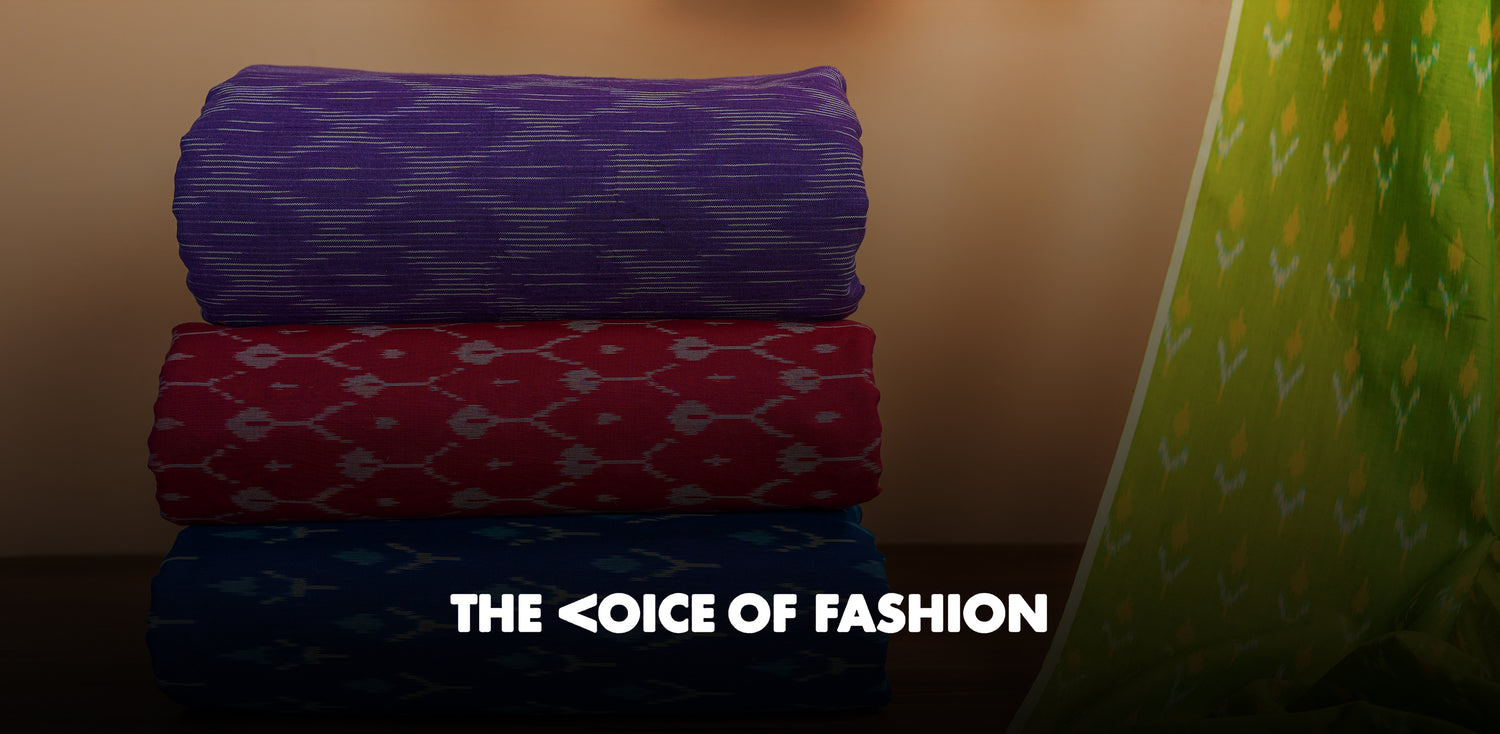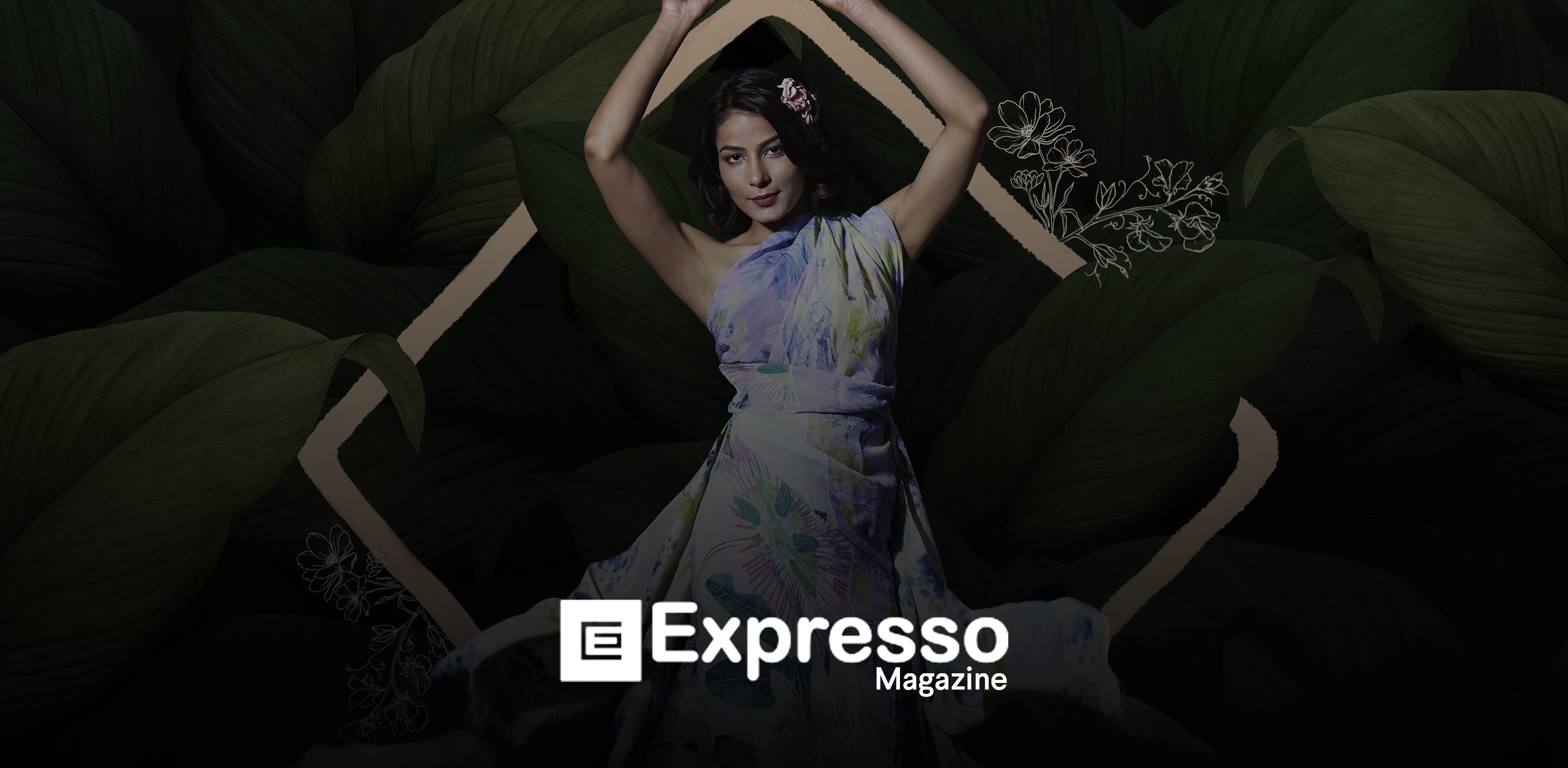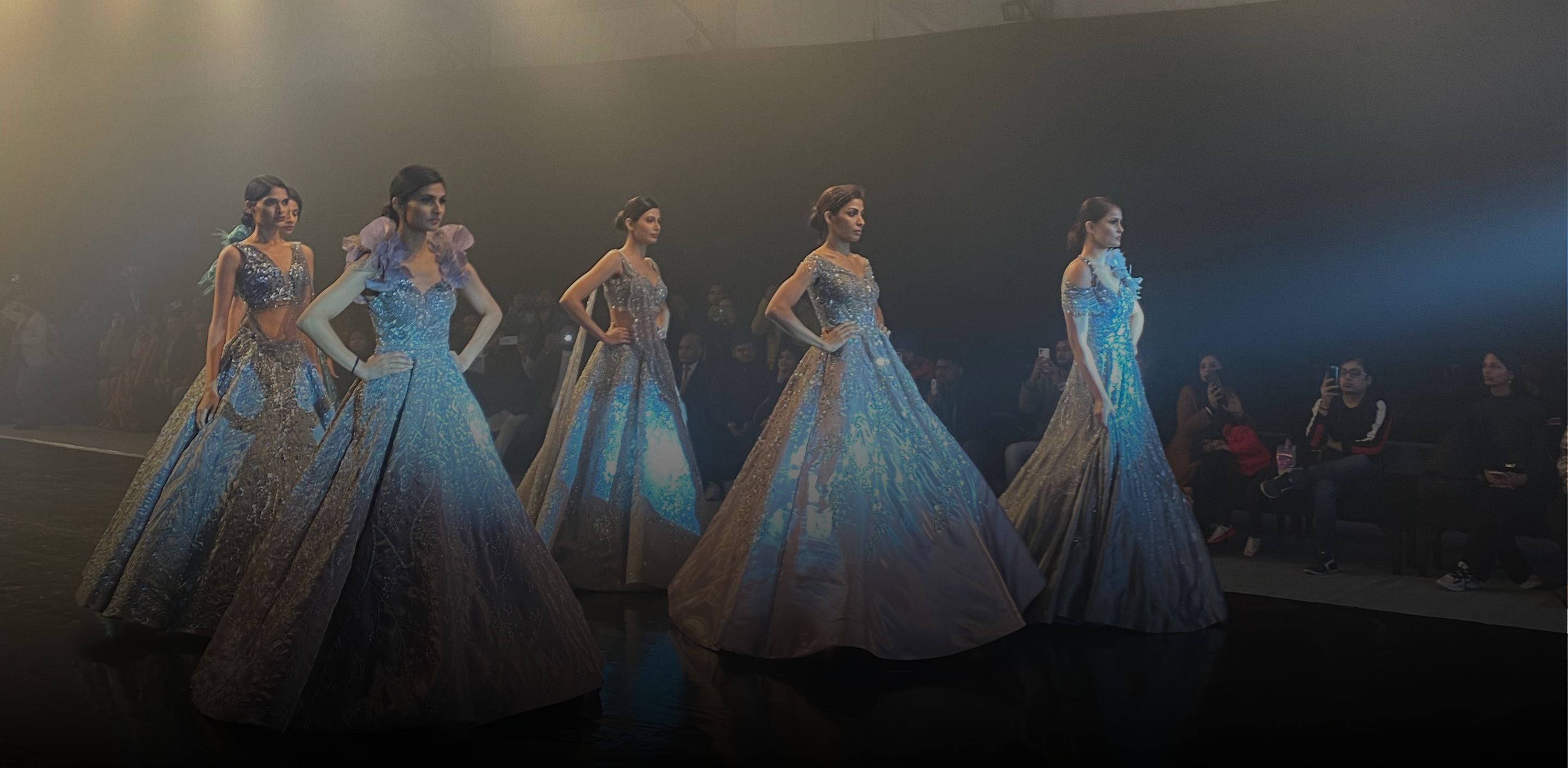AS PUBLISHED IN THE VOICE OF FASHION ON JULY 18, 2022
From fashion ramps and home decor to stationery, Ikat continues its influence
By Ektaa Malik
From fashion ramps to restaurant uniforms, home decor to stationery, Ikat, the flag of post-Independent India’s handloom revival continues its influence
Actor Tara Sutaria recently wore an Ikat halter top and pant set from the indie label, The Ikat Story, to a film event.
In June, Fabriclore, a homegrown textiles brand unveiled a line of Ikat fabrics. “We sold the entire collection. It’s an evergreen part of our fabric repertory,” says Anupam Arya, VP and co-founder, of Fabriclore.
Meanwhile, Westside, the Tata-owned clothing retail chain, has recently launched a line of Ikat clothing—comprising dresses, joggers, and crop tops. You can find restaurant servers in Ikat uniforms, Ikat fabric on Amazon Karigar, derivations imitating Telia Rumaal (handwoven square textiles from Andhra Pradesh) in international products, and prêt collections, notebooks wearing Ikat, and shoes molded in Ikat fabric too.
Ikat is persistent, and prevalent. While most of these examples are printed or power loom versions that use the motif and design formulations of the original, hand-dyed, hand-woven weave, the enduring popularity of Ikat as a design is a story.
The word, Ikat, of Indonesian origin, means, ‘to bind’. It follows a resist-dyeing technique—the yarn is dyed before it is woven—making it unique among textiles. Single Ikat is a kind of interweaving tie-and-dye yarn with plain weft. Double Ikat, on the other hand, uses resist-dyeing techniques to both warp and weft before weaving.
Ikat is woven in several countries. In India, besides Odisha’s Sambalpuri and Nagabandha Ikats, the Andhra-Telangana region is known for Telia Rumaal and Pochampalli Ikat. In Gujarat, besides Saurashtra, the textile is also woven in Patan—famed for its double Ikat Patola.
All these kinds of Ikat have been curated for numerous textile exhibitions across the world. Some like Patan Patola have pride of place in the most known global textile museums. Ikat can create beautiful blurry patterns without clean and sharp borders, or be so architectural in effect that every line, circle, and square is defined geometrically. It is evocative for many practitioners and designers.
“I felt an almost visceral response to the weave, I saw the challenge in the weaving, admired the distinctive ‘blurriness’ of the motifs that cleverly merged with the background,” says national award-winning textile revivalist Madhu Jain explaining what may look like waves of blurry patterns to those unfamiliar with textiles. “As it has a particularly tough resist-dyeing technique, even master weavers take years to perfect the technique,” she adds, I felt an almost visceral response to the weave, I saw the challenge in the weaving, admired the distinctive ‘blurriness’ of the motifs that cleverly merged with the background,”
Ikat in Fashion
Inside the original, the inspired, the derivatives, and blatant print imitations, is a universe of Ikat. Which is in fashion. The potential of woven Ikat has attracted noted Indian designers like Rina Singh of eka or Suket Dhir to just name two, to create high fashion collections targeted also for global stores that Indian handlooms as prêt garments.
In 2020, Singh collaborated with the Telangana State Handloom Weavers Cooperative Society Ltd to create a line featuring deconstructed Ikat weaves. While Dhir’s ingeniously woven collection of oversized Ikat suits for men won him the International Woolmark Prize in 2016.

Spurred by this dynamism, several smaller independent labels and initiatives have introduced new iterations of the weave over the last decade. “In 2015, I started designing outfits for myself from old Ikat bedcovers. They became a hit with friends,” says Chandni Sareen, founder and designer of The Ikat Story which specialises in making contemporary clothing out of artisanal Ikat textiles.
Kirti Poonia, who is on the board of Okhai, the Tata Chemicals-backed social enterprise that works with women artisans, attributes the textile’s popularity to its embrace by new labels and designers. “In 2015, new, younger designers, helped in mainstreaming the vocabulary of the weave in pop fashion. When shorts and bomber jackets started being designed, that’s when it started to register with the young,” says Poonia.
Examples abound. Ahmedabad-based label Tilla by Aratrik Devvarman helms a vintage project, which repurposes heirloom fabrics including Ikat. Nor Black Nor White, Indigene, Malie and Alamelu by Angadi in Bengaluru are among other labels experimenting with Ikat.
Ikat has formed a curious and commercially palpable trajectory without being fazed by market challenges around purist handlooms versus prints, handwoven versus powerloom.
Madhu Jain, however, recalls a challenging time from the past. “In the late nineties and the early 2000s, handlooms, including Ikat, were not popular. There was a surge in buying machine-made fabrics because of affordability and ease of procurement,” she says.
The Real Surge is Powerloom and Printed
The surge we now witness too rests primarily in powerloom and printed Ikat. “This [machine-made version] kind of Ikat print costs as little as ₹200 per metre in local markets though it’s sold as handwoven Ikat. I have had customers question the pricing of clothes at The Ikat Story, so I had to explain this,” says Sareen.
On the Karigar section of Amazon.in, a throng of Ikat products (some even labelled as Ikat) pop up. They include dupattas, saris, shirts, fabric for kurtas sets and cushion covers. More than a 100 products are currently displayed there. The starting price for these is ₹500 while a Sambalpuri silk Ikat sari is for ₹6,200. On Myntra, Ikat is a part of the platform’s in-house label Taavi which retails hand-woven textiles. It includes Ikat kurtas for men and women, dresses, tunics, shirts and dupattas. The price range moves from ₹700 approximately to a few thousand rupees. Jaypore which as a marketplace has a slightly elevated curation of crafts and handlooms, has a dedicated section called Ikat Saga. The starting price: ₹3,500 approximately. Ikat garments created by Indian designers on the other hand start from ₹6,000-₹8,000 apiece and go up to more than ₹20,000. Saris would be above ₹30,000.

Poonia adds that the fabric’s gender-neutral appeal is an X-factor behind its popularity—across mediums. “Even now it’s rare to see many men wear a floral shirt, but they will wear an Ikat kurta or shirt. It is worn by all genders,” she says.
Many industry insiders hope that printed fabric works as a familiarising instance for buyers making them curious about the artisanal weave. “The only good thing about the ubiquity and availability of Ikat, even at the neighbourhood Big Bazaar is that it’s now accessible at affordable price points,” says Poonia. “This is democratisation but it’s a short-term gain. In the long run, it’s not good for an artisanal craft because many weavers may start to think why should they put in so much effort.”
As motif and design vocabulary, Ikat is also popular in other product categories like upholstery, handbags, footwear and stationery. Owing to its complex make and intricate design, Ikat can also be seen as art. “I can just frame an artisanal handwoven Ikat textile and put it up on my wall. It is eye catching and it makes a statement,” says Sareen.
“It was once unimaginable that Ikat could be produced on the power loom but the warp aspect of the weave has been replicated. The government had preempted it with The Handlooms (Reservation of Articles for Production) Act of 1986 defining how certain weaves can only be produced on a handloom. These two versions, the Ikat print and the artisanal weave co-exist today–but the print and the handwoven should be clearly demarcated,” asserts Gunjan Jain, textile designer and founder of Vriksh Design Studio which specialises in Ikat.
Why Ikat Endures
For Dipali Patwa, group head of brand, media and community at Indian clothing and lifestyle brand Fabindia, Ikat is popular as it blends seamlessly with many global cultures. “There are many countries and cultures who have their own Ikat weaving techniques, independent of each other, like Uzbekistan, Indonesia, Africa and even South America. So it connects instantly,” shares Patwa. Gunjan adds that there are at least 30 countries that have distinctive Ikat weaving techniques. “I was surprised when I came to know that even France had its own fine bespoke Ikat tradition,” she notes.

Handwoven Ikat doesn’t fade or diminish in quality over time, compared to other textiles. “As the dyeing happens at the yarn stage, colours penetrate deep into fibres. The colour is long lasting, it’s almost forever as compared to other weaving techniques native to India,” says Gunjan. Vinita Passary, co-founder of the Hyderabad-based label Translate, agrees. “The yarn undergoes a lot of pressure on the loom and it’s tightly woven. After all that intense weaving and dyeing, the fabric is set for a long life,” she says.
For Madhu Jain, the distinct weaving method that makes Ikat appealing is a key draw. “The complexity and diverse weaving methods of this handloom are mind boggling—no two styles are the same. The motifs, too, are constantly being reinvented, hence creating a novelty in the weave,” shares Madhu.
Badge and Beautiful
Ikat was a big part of the handloom revival movement of the Eighties. On the one hand, it is associated with cultural and textile connoisseurs of post-Independent India—late Prime Minister Indira Gandhi as well as Pupul Jayakar and Kamaladevi Chattopadhyaya among several other luminaries in literature and crafts. On the other, it was the preferred weave of civil society and Left-wing intellectuals, activists, artists, journalists and theatre artists, colloquially called the jholawallahs.

“When we wear handloom, the message that we send out, apart from the aesthetic, is that we care. We care for the people who make it and for the country,” adds Poonia. “We have a history of the charkha and the khadi—they were the tools and motifs for our freedom movement. Ikat fashion, and the weaves by extension, come out of that history,” adds Gunjan.




